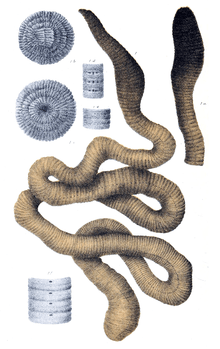Giant Gippsland earthworm
The giant Gippsland earthworm, Megascolides australis, is one of Australia's 1,000 native earthworm species. It is also commonly known as karmai, taken from the Bunwurrung language.[1]
| Giant Gippsland earthworm | |
|---|---|
 | |
| Scientific classification | |
| Kingdom: | |
| Phylum: | |
| Class: | |
| Subclass: | |
| Family: | |
| Genus: | |
| Species: | M. australis |
| Binomial name | |
| Megascolides australis McCoy, 1878 | |
Description
These giant earthworms average 1 metre (3.3 ft) long and 2 centimetres (0.79 in) in diameter and can reach 3 metres (9.8 ft) in length; however, their body is able to expand and contract making them appear much larger. On average they weigh about 200 grams (0.44 lb).[2][3] They have a dark purple head and a blue-grey body, and about 300 to 400 body segments.[1]
Ecology
They live in the subsoil of blue, grey or red clay soils along stream banks and some south- or west-facing hills of their remaining habitat which is in Gippsland in Victoria, Australia. These worms live in deep burrow systems and require water in their environment to respire.[1] They have relatively long life spans for invertebrates and can take 5 years to reach maturity. They breed in the warmer months and produce egg capsules that are 4 centimetres (1.6 in) to 7 centimetres (2.8 in) in length which are laid in their burrows. When these worms hatch in 12 months they are around 20 centimetres (7.9 in) long at birth.
Unlike most earthworms which deposit castings on the surface, they spend almost all their time in burrows about 52 centimetres (20 in) in depth and deposit their castings there, and can generally only be flushed out by heavy rain.[2] They are usually very sluggish, but when they move rapidly through their burrows, it can cause an audible gurgling or sucking sound which allows them to be detected.[4][5]
Threatened status
Gippsland earthworm colonies are small and isolated,[6] and the species' low reproductive rates and slow maturation make those small populations vulnerable.[6] Their natural habitats are grasslands, and while they can survive beneath pastures,[6] cultivation, heavy cattle grazing and effluent run-off are adversarial to the species.[6] The Gippsland earthworm requires moist loamy soil to thrive; dense tree planting negatively affects soil humidity, which in turn negatively affects the species' habitat.[6] No successful breeding has yet been achieved in captivity.[2][1]
Education
Until it closed in 2012 amid animal welfare concerns,[7] Wildlife Wonderland Park near Bass, Victoria, was home to the Giant Earthworm Museum.[8] Inside the worm-shaped museum, visitors could crawl through a magnified replica of a worm burrow and a simulated worm's stomach. Displays and educational material on the giant Gippsland earthworm and other natural history of Gippsland were also featured.
Tourism
Interest in the Giant Gippsland earthworm has been exploited by the local tourist industry with an annual Karmai festival in Korumburra and a Giant Worm Museum at Bass.[9]
See also
- Giant Palouse earthworm - A vulnerable North American species.
- Oregon giant earthworm - A relative of the Palouse earthworm. Specimens have been recorded at 1.3 m (4 feet) long.
- Lake Pedder earthworm - Listed as the first "extinct" worm species from its original unique Tasmanian habitat.
- Lumbricus badensis - Giant (Badish) earthworm.
- Microchaetus rappi - Giant South African earthworm.
References
- "Megascolides australis — Giant Gippsland Earthworm". AU Environment. Retrieved 14 December 2013.
- "Giant Gippsland Earthworm". Museum Victoria. Archived from the original on 14 December 2013. Retrieved 14 December 2013.
- Diversity of Soil Fauna and Ecosystem Function, Biology International. Retrieved on October 23, 2008.
- Action Statement: Giant Gippsland Earthworm. Retrieved on July 23, 2012.
- "Archived copy". Archived from the original on 2016-09-19. Retrieved 2013-12-14.CS1 maint: archived copy as title (link)
- Victoria Resources Online: Giant Gippsland Earthworm Archived 2013-10-26 at the Wayback Machine. Retrieved on July 23, 2012.
- "Closure of Wildlife Wonderland Park near Bass". Victoria Department of Environment and Primary Industries.
- "Giant Earthworm Museum". Atlas Obscura. Retrieved 29 March 2014.
- "National Recovery Plan for the Giant Gippsland Earthworm" (PDF). Department of Sustainability and Environment. 2010.
- World Conservation Monitoring Centre (1996). "Megascolides australis". IUCN Red List of Threatened Species. 1996. Retrieved 11 May 2006.CS1 maint: ref=harv (link) Listed as Vulnerable (VU D2 v2.3)
External links
- Giant Gippsland earthworm at the Museum Victoria website
